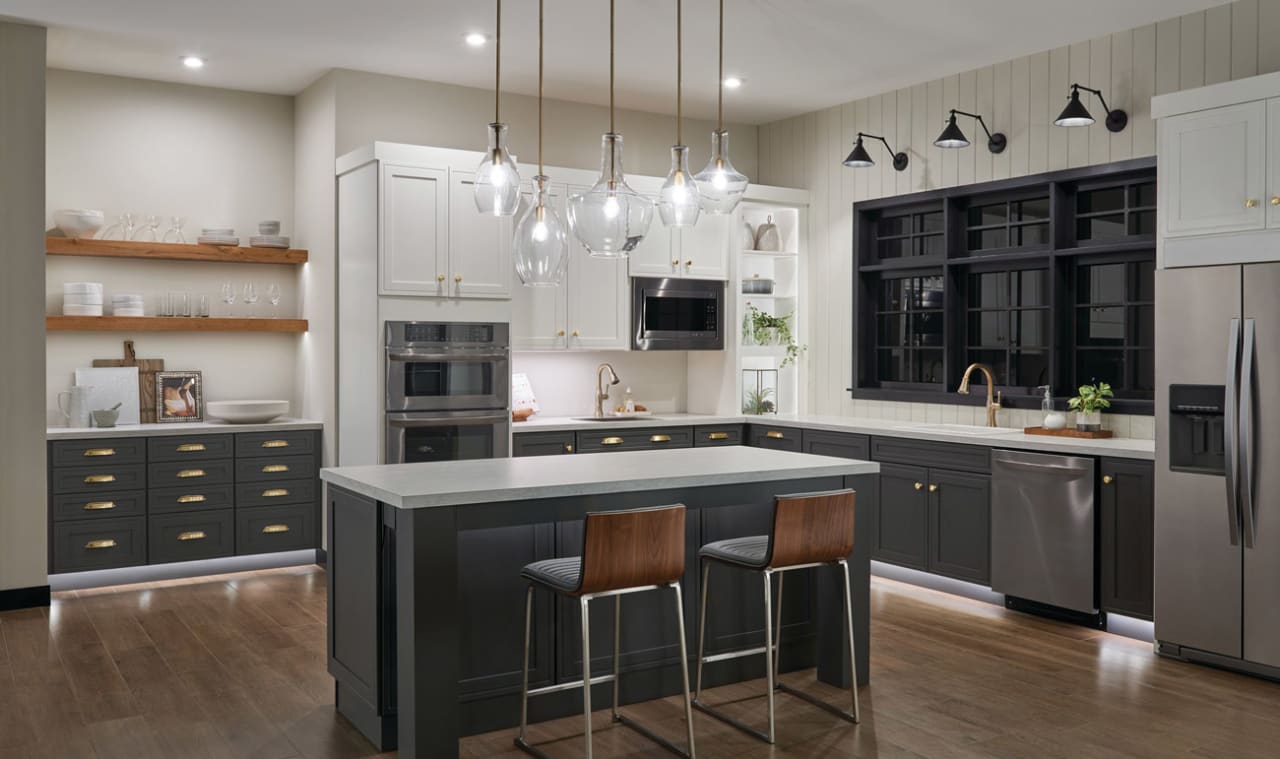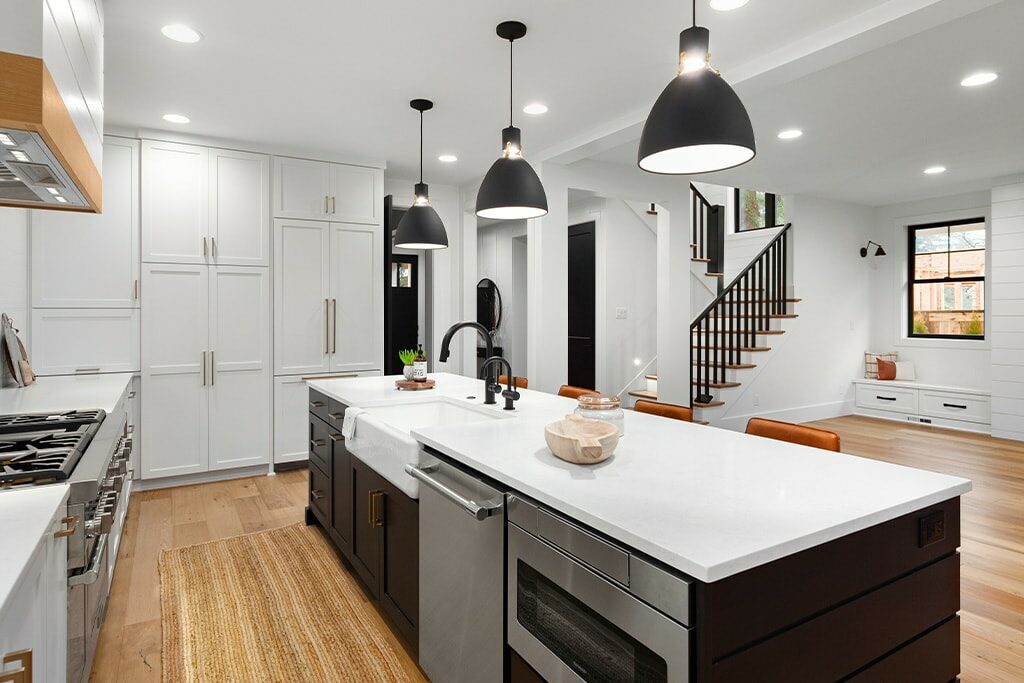When it comes to designing a functional and visually appealing kitchen, one of the most important aspects to consider is kitchen lighting. Proper lighting not only enhances the overall aesthetic of the space but also improves the functionality and safety of the kitchen. Whether you’re preparing meals or entertaining guests, the right kitchen lighting can make all the difference. In this guide, we’ll dive into the various types of kitchen lighting, the factors to consider when choosing lighting fixtures, and tips to create the perfect atmosphere in your kitchen.
Types of Kitchen Lighting
Three primary types of kitchen lighting work together to create a balanced and well-lit space. These include ambient, task, and accent lighting. Each type serves a unique purpose, and understanding how to incorporate them into your kitchen design is crucial.

1. Ambient Kitchen Lighting
Ambient lighting is the foundation of your kitchen lighting scheme. It provides general illumination for the entire space, ensuring that you can move around and perform tasks without straining your eyes. Ambient lighting is typically achieved through ceiling-mounted fixtures, such as recessed lights, chandeliers, or pendant lights.
When selecting ambient lighting, it’s essential to choose fixtures that distribute light evenly across the room. Consider the size of your kitchen and the layout when determining the appropriate number of light sources needed to achieve uniform brightness.
2. Task Kitchen Lighting
Task lighting is designed to provide focused illumination for specific kitchen tasks, such as chopping vegetables, cooking, or cleaning. This type of kitchen lighting is usually brighter and more direct, helping to minimize shadows and enhance visibility in work areas.
Common options for task lighting include under-cabinet lights, track lighting, and pendant lights above kitchen islands or countertops. By strategically placing task lighting in areas where you perform most of your cooking activities, you can ensure that your kitchen remains efficient and safe.
3. Accent Kitchen Lighting
Accent lighting is used to highlight specific features or areas in the kitchen, such as artwork, architectural details, or decorative elements. This type of lighting adds visual interest and depth to the space, creating a more inviting atmosphere.
Accent lighting can be achieved using adjustable track lights, wall-mounted sconces, or LED strip lights. When used in combination with ambient and task lighting, accent lighting can transform your kitchen into a visually stunning space.
Factors to Consider When Choosing Kitchen Lighting
Choosing the right kitchen lighting requires careful consideration of various factors. Here are some essential things to keep in mind when selecting lighting fixtures for your kitchen:
1. Size and Layout of Your Kitchen
The size and layout of your kitchen play a significant role in determining the types and placement of lighting fixtures. For larger kitchens, you may need multiple light sources to ensure that the space is evenly illuminated. On the other hand, smaller kitchens may require fewer fixtures but should still have enough light for specific tasks.
Consider the layout of your kitchen, including the placement of cabinets, countertops, and appliances. This will help you identify the areas where task lighting and accent lighting will be most effective.
2. Lighting Style and Design
Your kitchen lighting should complement the overall style and design of your kitchen. From modern to traditional, there are countless lighting fixtures available in a variety of designs to suit your preferences. Whether you opt for sleek pendant lights, rustic chandeliers, or contemporary track lighting, make sure the style of your fixtures enhances the overall look of the room.
3. Energy Efficiency
With the growing focus on sustainability and energy conservation, energy-efficient lighting options are becoming increasingly popular. LED lights are an excellent choice for kitchen lighting because they consume less energy, last longer, and produce less heat compared to traditional incandescent bulbs. Installing dimmable LEDs can also help you adjust the brightness of your kitchen lighting based on your needs.
4. Light Color and Temperature
The color temperature of your kitchen lighting can impact the mood and functionality of the space. Warm white lighting (2700K-3000K) creates a cozy and inviting atmosphere, while cool white (3500K-4100K) and daylight (5000K-6500K) lighting provide bright, crisp illumination suitable for task-oriented areas.
When choosing your kitchen lighting, consider the overall mood you want to create. For instance, warm white lighting may be ideal for the dining area, while cool or daylight lighting is better for food preparation areas.
Tips for Effective Kitchen Lighting
Now that you understand the different types of kitchen lighting and the factors to consider, here are some additional tips to help you achieve the perfect lighting setup for your kitchen:
1. Layer Your Lighting
To create a well-balanced and functional lighting design, it’s essential to layer different types of kitchen lighting. Combining ambient, task, and accent lighting ensures that the space is well-lit for both general activities and specific tasks.
For example, you can use recessed lighting for ambient illumination, under-cabinet lights for task lighting, and pendant lights or track lights to add accent lighting above the kitchen island or countertops. Layering your lighting not only improves visibility but also adds depth and dimension to the room.
2. Focus on Key Work Areas
In the kitchen, certain areas require more focused lighting to ensure tasks are done safely and efficiently. The kitchen countertop, stove, and sink are key work areas that need sufficient task lighting. Installing under-cabinet lights, pendant lights, or track lighting above these areas can help reduce shadows and provide better visibility for meal preparation.
3. Use Dimmers for Versatility
Adding dimmer switches to your kitchen lighting can offer versatility in how you use the space. Dimming your lights allows you to adjust the brightness according to the time of day, the task at hand, or the mood you want to create. For example, dim the lights during dinner parties to create a relaxed ambiance, and brighten them up when cooking or cleaning.
4. Consider Smart Kitchen Lighting
Smart lighting systems are gaining popularity in modern kitchens. With the ability to control your lights via voice commands or mobile apps, smart lighting offers convenience and flexibility. You can program your kitchen lighting to turn on and off at specific times, adjust the brightness, or change the color temperature based on your needs.
Conclusion: Finding the Perfect Kitchen Lighting Solution
Kitchen lighting is a crucial element in creating a functional, stylish, and welcoming cooking space. By incorporating ambient, task, and accent lighting, you can enhance the overall look and feel of your kitchen while ensuring that it meets your practical needs. When selecting kitchen lighting, consider factors such as size, design, energy efficiency, and lighting temperature to make informed decisions.
Whether you’re renovating an existing kitchen or designing a new one, taking the time to carefully plan your kitchen lighting will transform your space into an inviting and efficient environment. With the right lighting, you’ll not only illuminate your kitchen but also enhance the atmosphere and functionality, making it a space you’ll love to cook and gather in for years to come.

